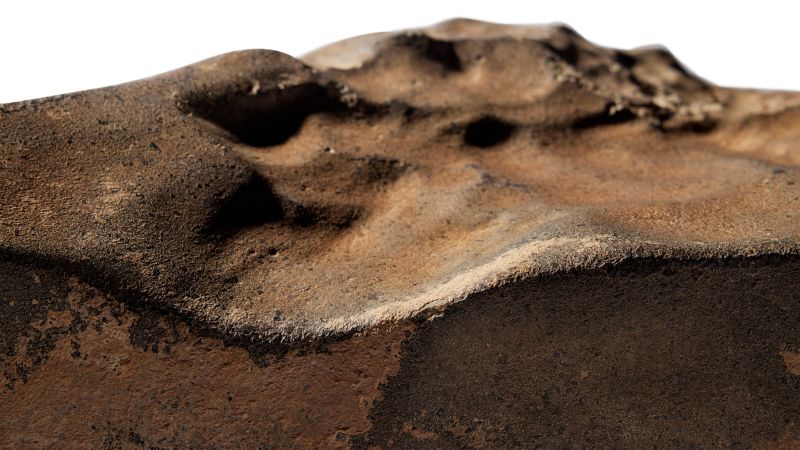Sign up for CNN’s Wonder Theory science newsletter. Explore the universe with news on fascinating discoveries, scientific advancements and more.
CNN
—
A meteorite that is the largest known piece of Mars on Earth is expected to fetch up to $4 million when it goes up for auction later this month.
Known as NWA 16788, the meteorite weighs 54 pounds (24.5 kilograms), massive compared with most Martian meteorites, which tend to be small fragments, auction house Sotheby’s said in a statement published Tuesday.
Meteorites are what’s left when a comet, asteroid or a meteoroid survives its passage through the earth’s atmosphere.
Discovered in November 2023 in the remote Agadez region of Niger, NWA 16788 is a “monumental specimen” that is around 70% larger than the next biggest piece of Mars ever found on Earth, according to Sotheby’s.
It is also incredibly rare: only around 400 Martian meteorites have ever been found on Earth.
“NWA 16788 is a discovery of extraordinary significance — the largest Martian meteorite ever found on Earth, and the most valuable of its kind ever offered at auction,” Cassandra Hatton, vice chairman of science and natural history at Sotheby’s, said in the statement.
“Weathered by its journey through space and time, its immense size and unmistakable red color sets it apart as a once-in-a-generation find. This remarkable meteorite provides a tangible connection to the red planet — our celestial neighbor that has long captured the human imagination,” she added.
Analysis of the meteorite’s internal composition has revealed that it was probably removed from the Martian surface and blasted into space by an asteroid impact that was so powerful it turned parts of the meteorite into glass.
A glassy crust can also be seen on its surface, formed as it hurtled through Earth’s atmosphere, according to Sotheby’s.
The meteorite will go under the hammer at Sotheby’s New York on July 16.
For some, the fact that the meteorite is being sold rather than donated to science is cause for concern.
“It would be a shame if it disappeared into the vault of an oligarch. It belongs in a museum, where it can be studied, and where it can be enjoyed by children and families and the public at large,” Steve Brusatte, a professor of paleontology and evolution at Scotland’s University of Edinburgh, told CNN on Wednesday.
But for Julia Cartwright, a planetary scientist and Independent Research Fellow in the Institute for Space/School of Physics & Astronomy at the University of Leicester, England, there is a balance to be struck.
“Ultimately, if there was no market for searching, collecting and selling meteorites, we would not have anywhere near as many in our collections — and this drives the science!” she told CNN on Wednesday, describing a “symbiotic relationship” between researchers and collectors.
“If samples weren’t being found, we would not have anywhere near as much to study, and so wouldn’t know as much as we do,” added Cartwright.
While she believes it would be great if this “really fabulous rock” were to be studied or displayed for the public to see, Cartwright underlined that a reference sample from the meteorite has been saved at the Purple Mountain Observatory in China.
While we don’t know where the meteorite will end up after the auction, Cartwright believes that “the scientific interest will remain, and the new owner may be very interested in learning from it, so we may still gather lots of science from this,” she said.
In February 2021, a Martian meteorite with the planet’s atmosphere entrapped in it went under the hammer at Christie’s auction house.
It sold for $200,000, far above its pre-auction estimate of $30,000-50,000.
